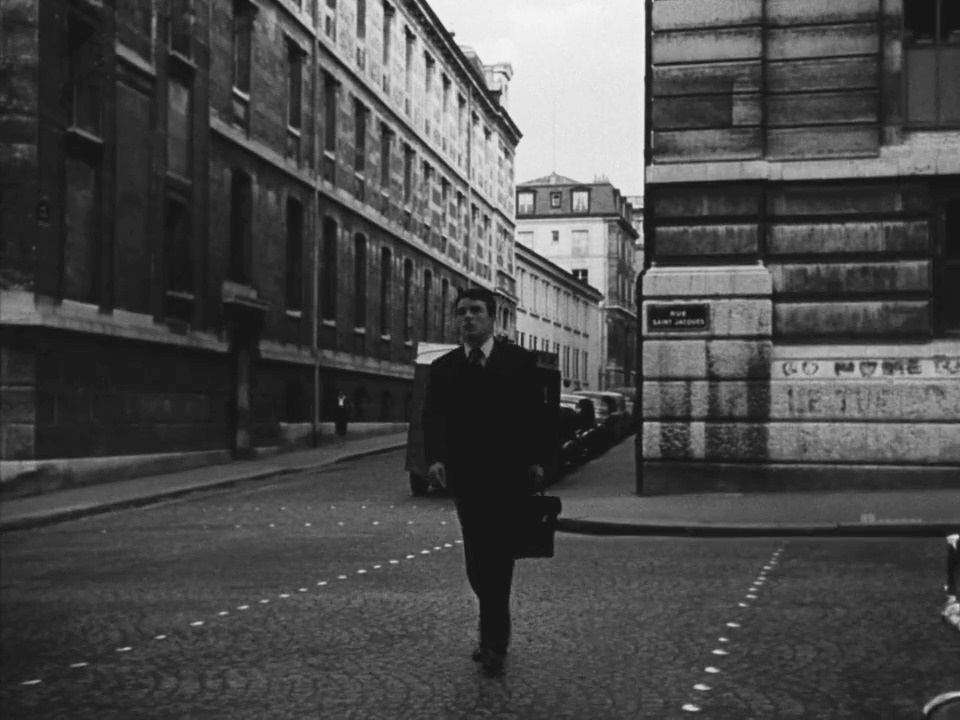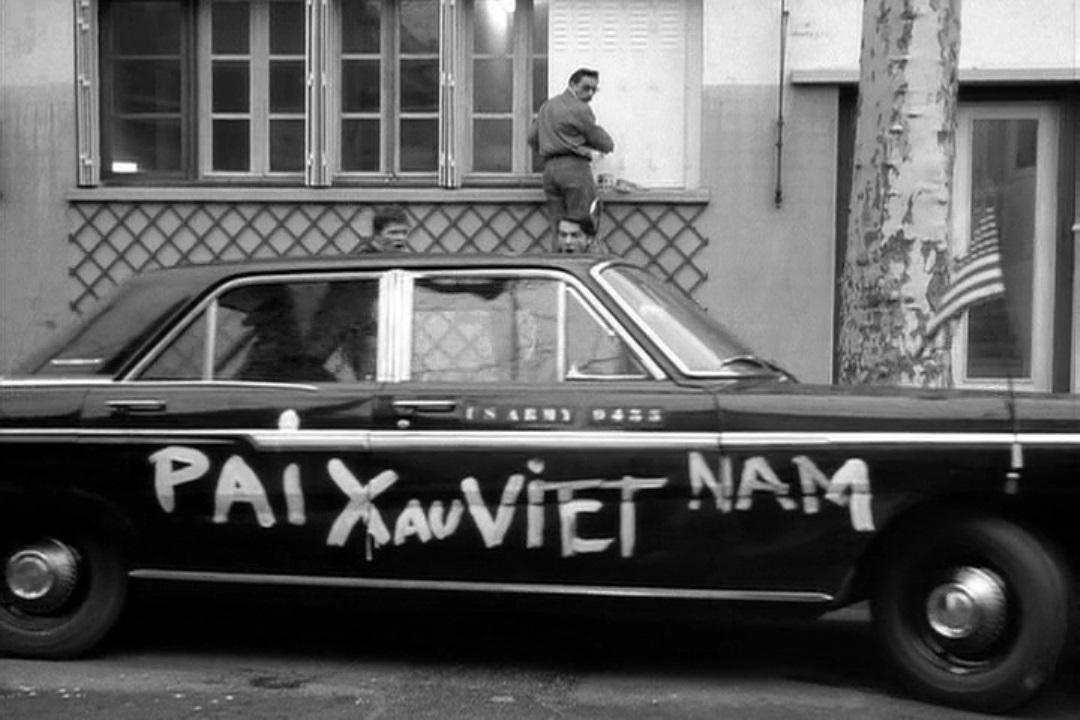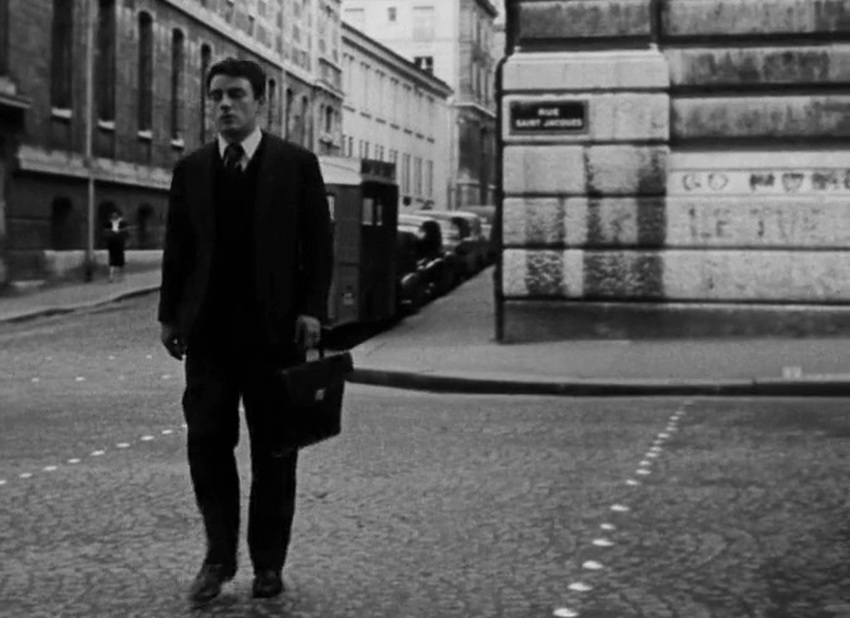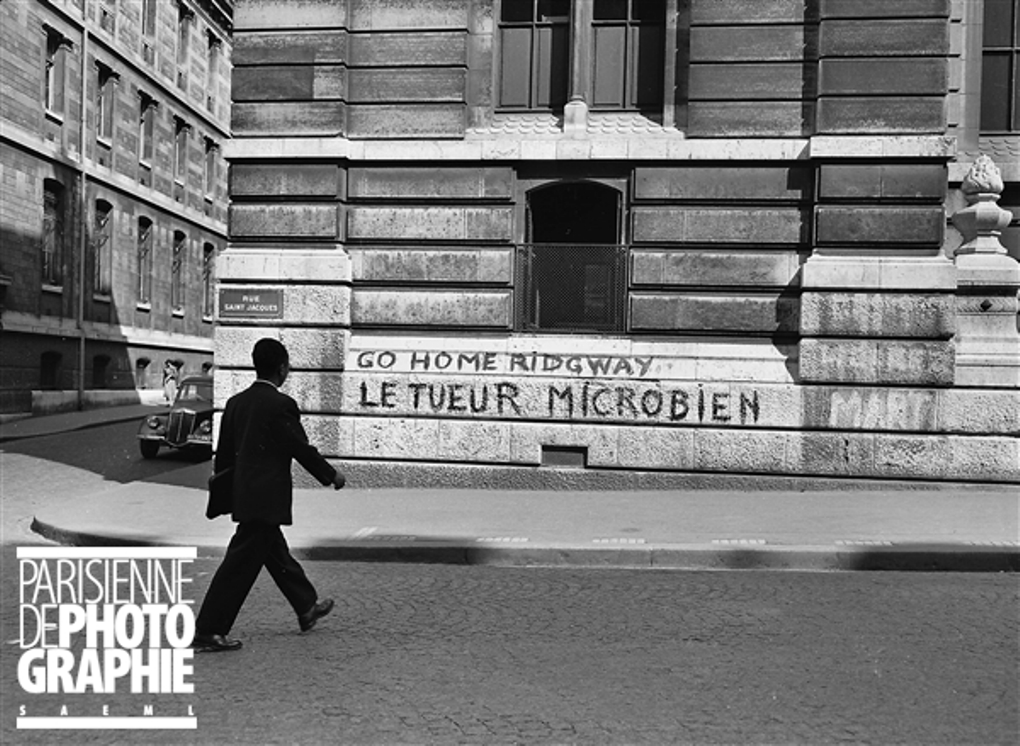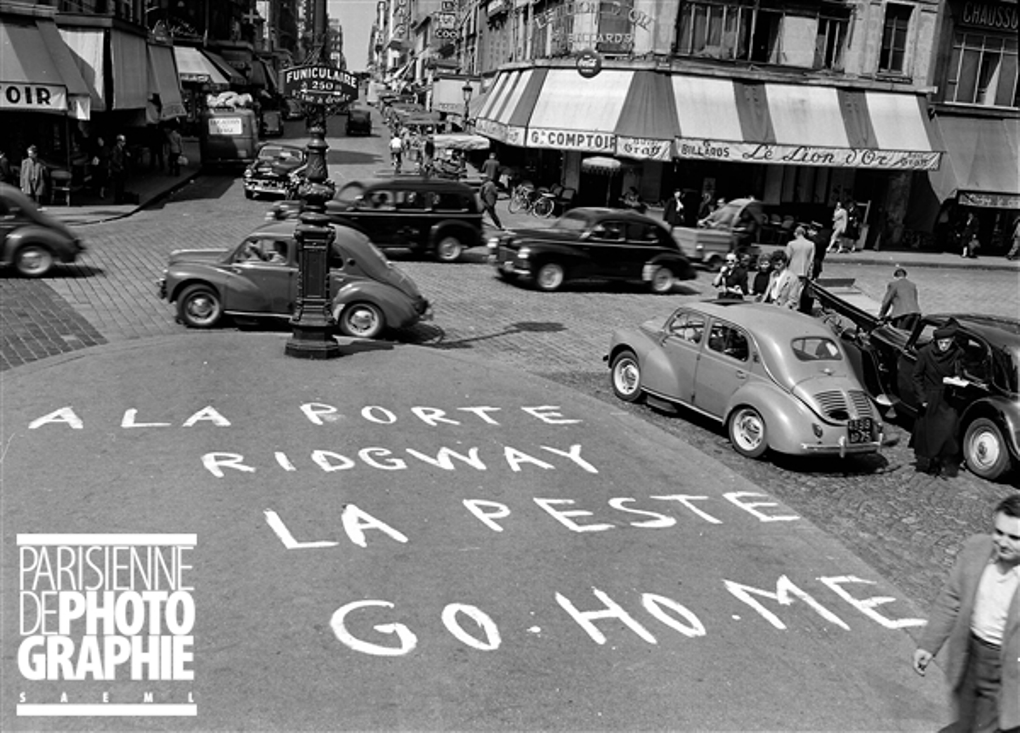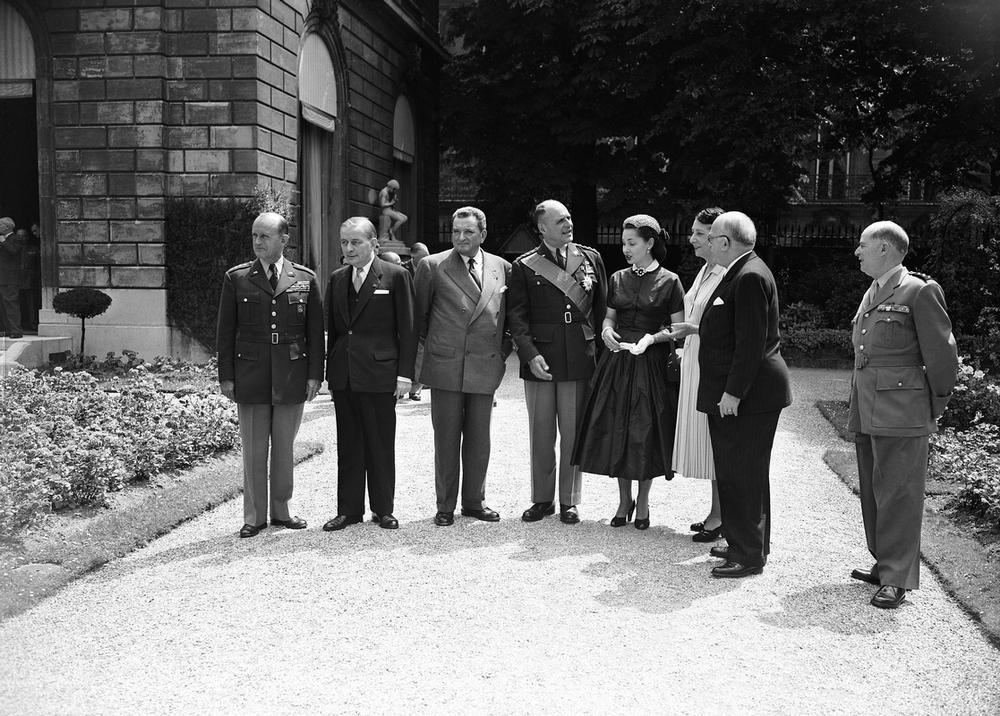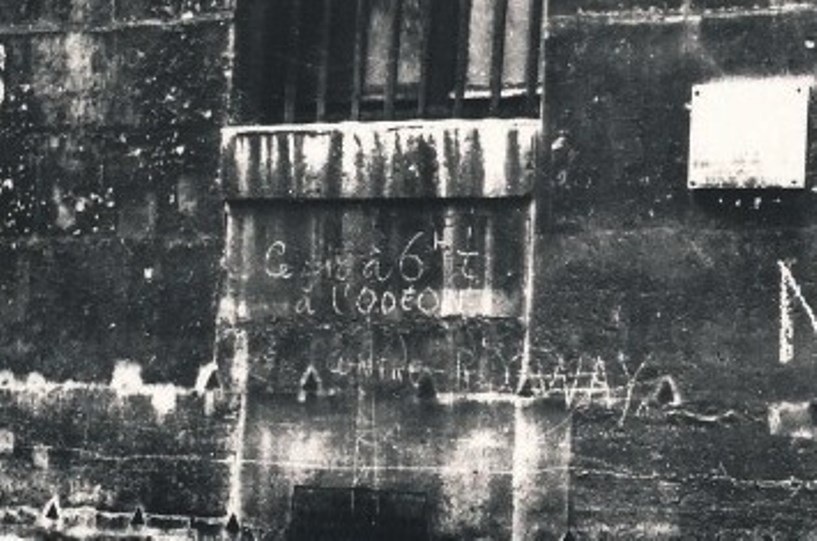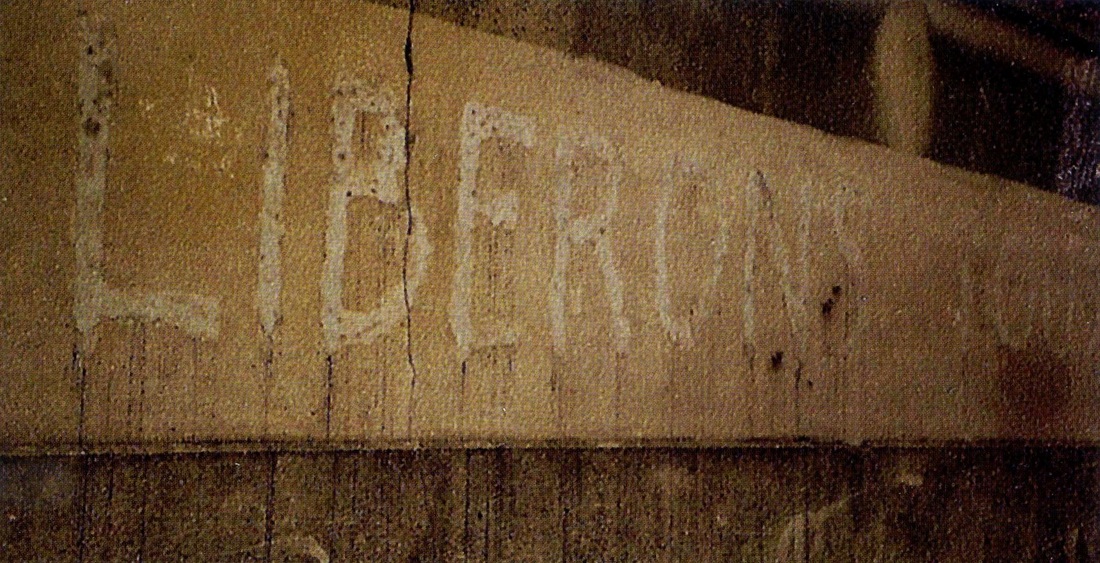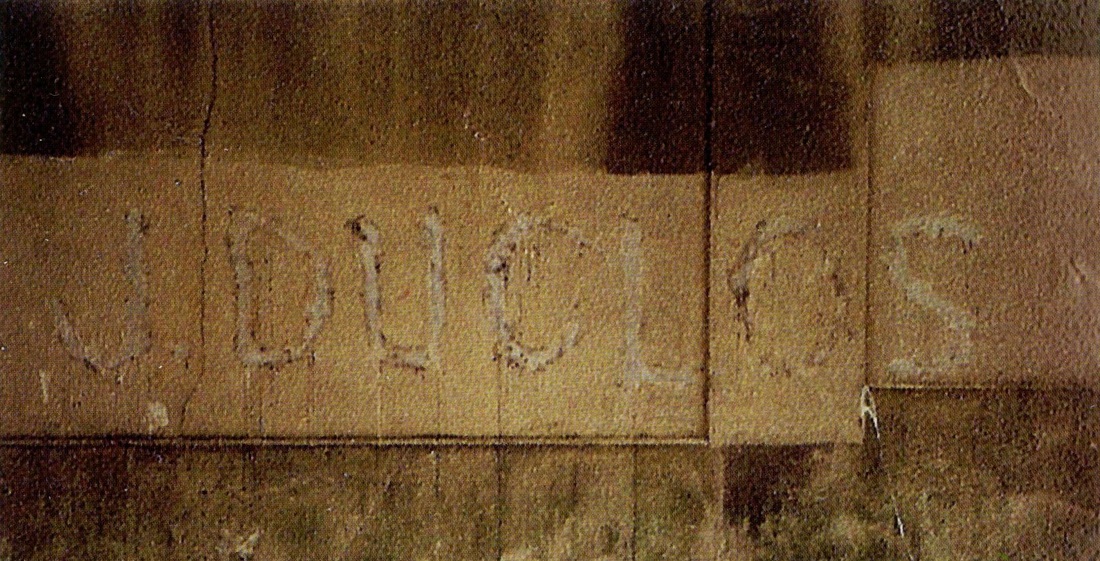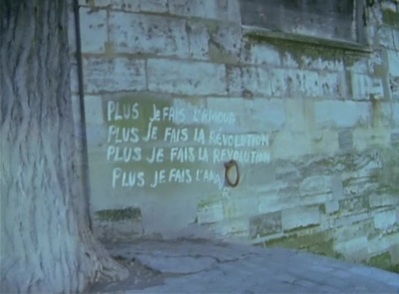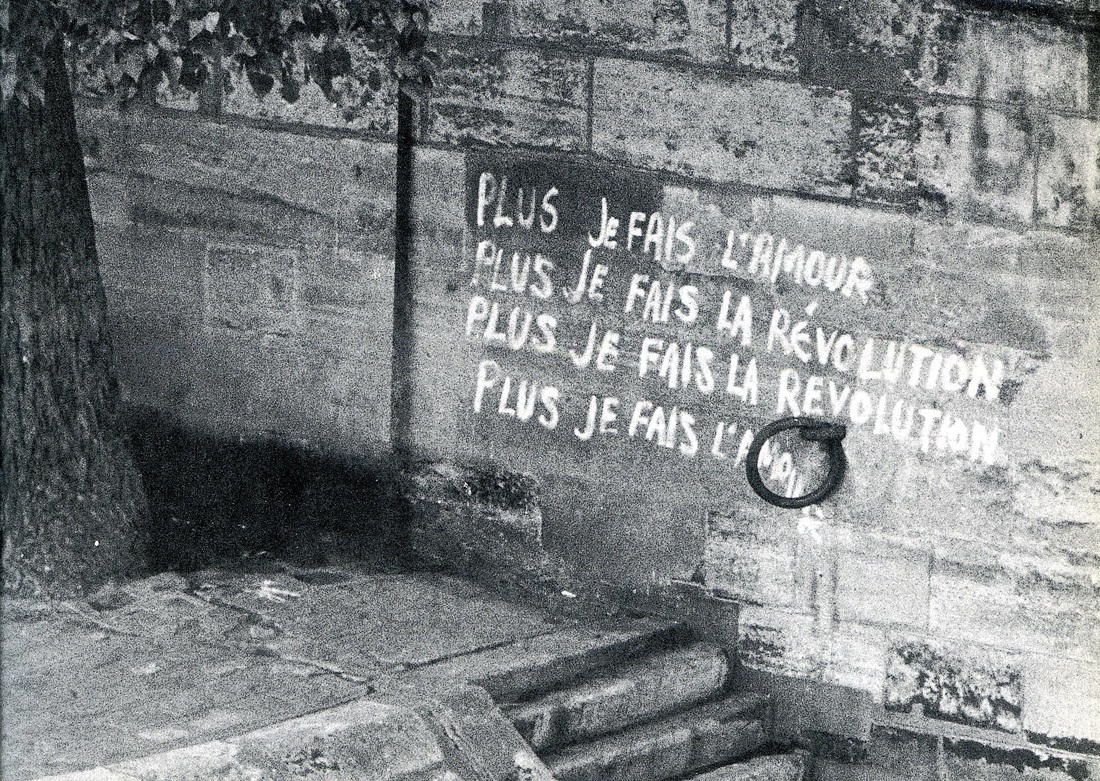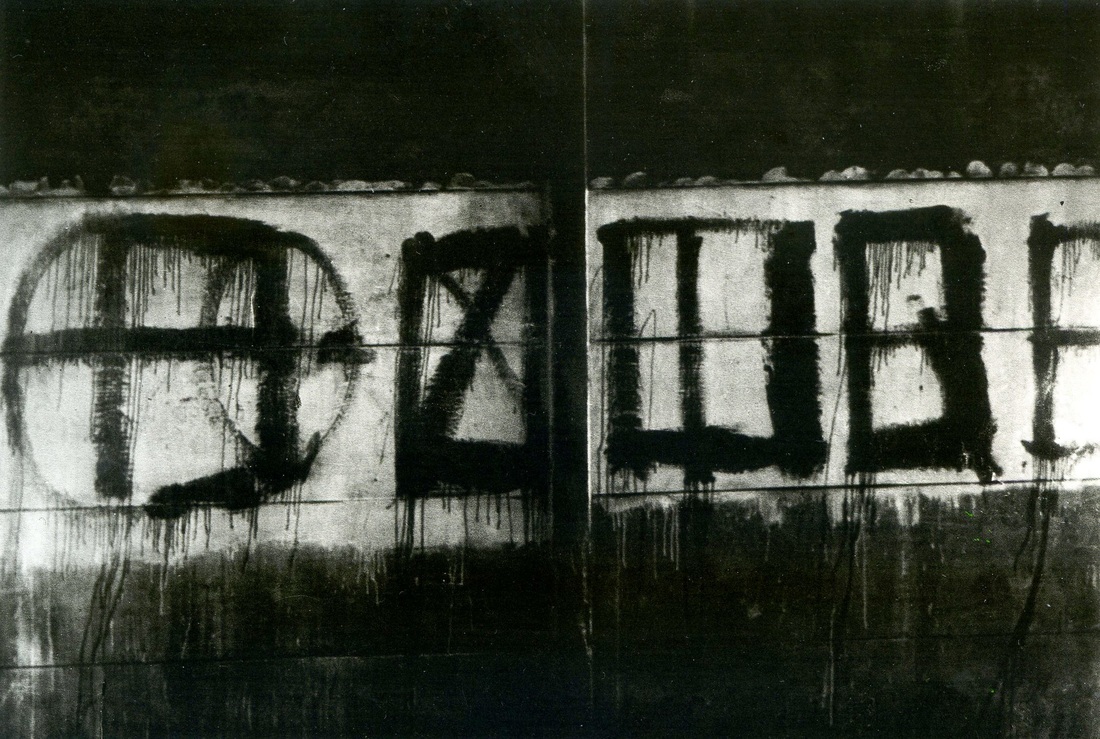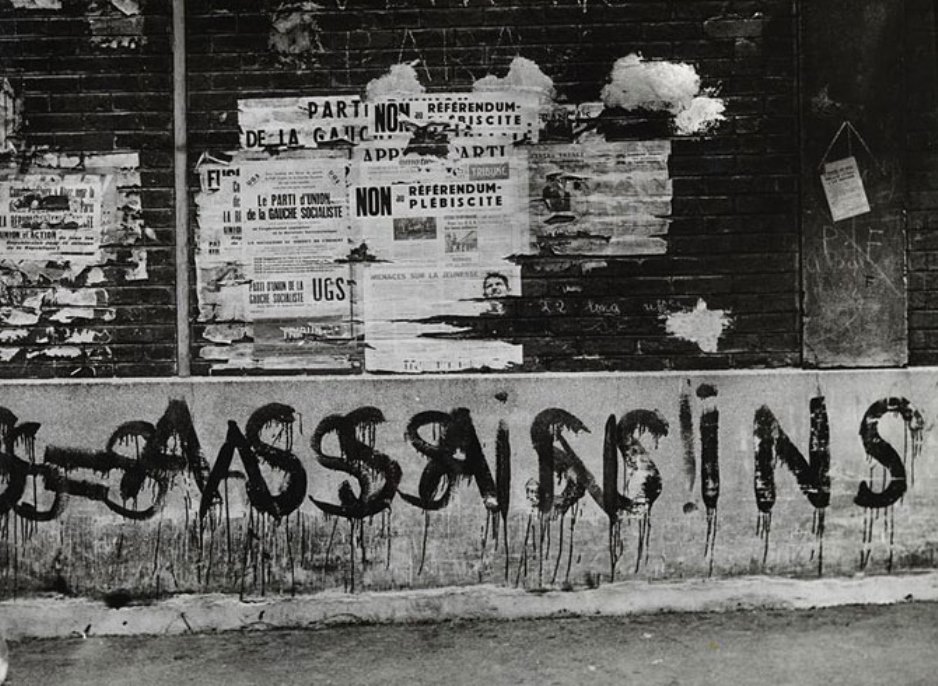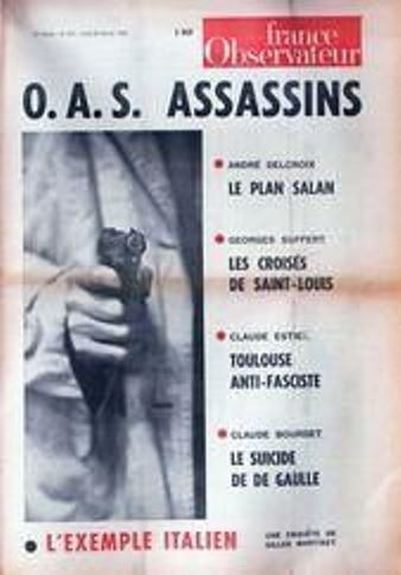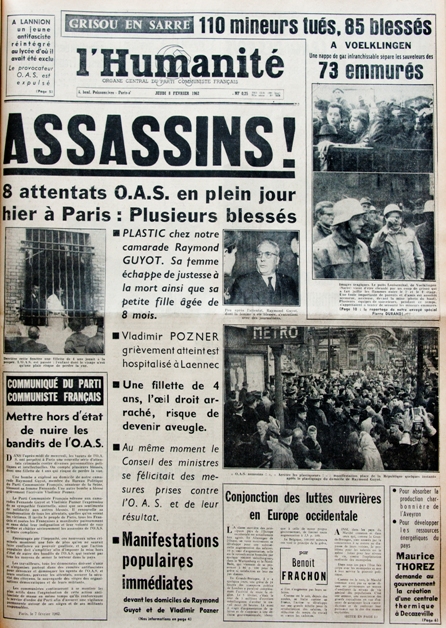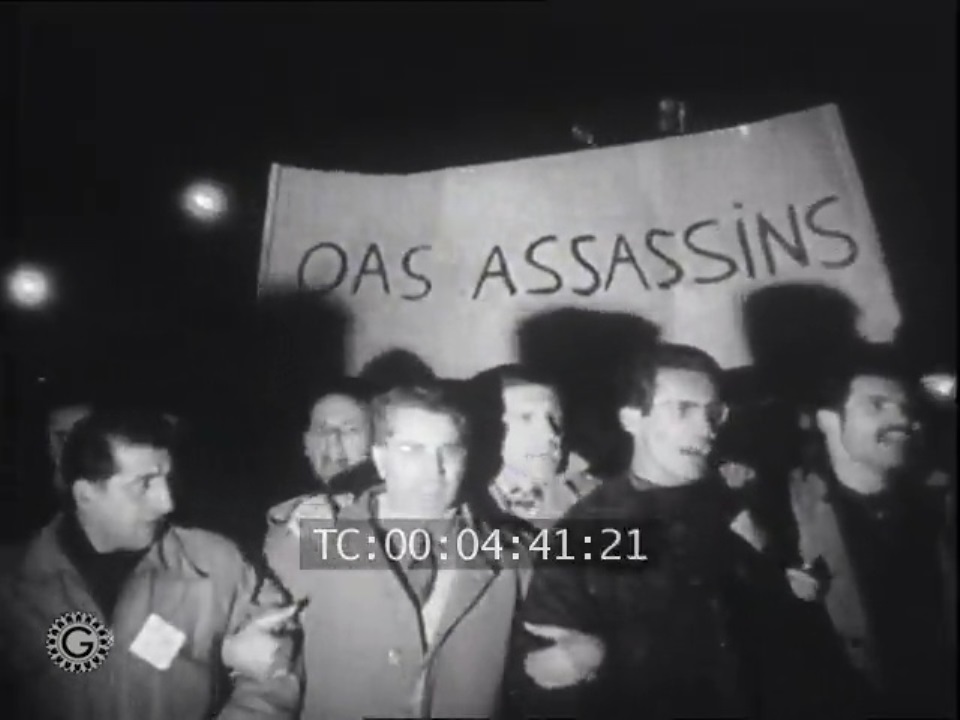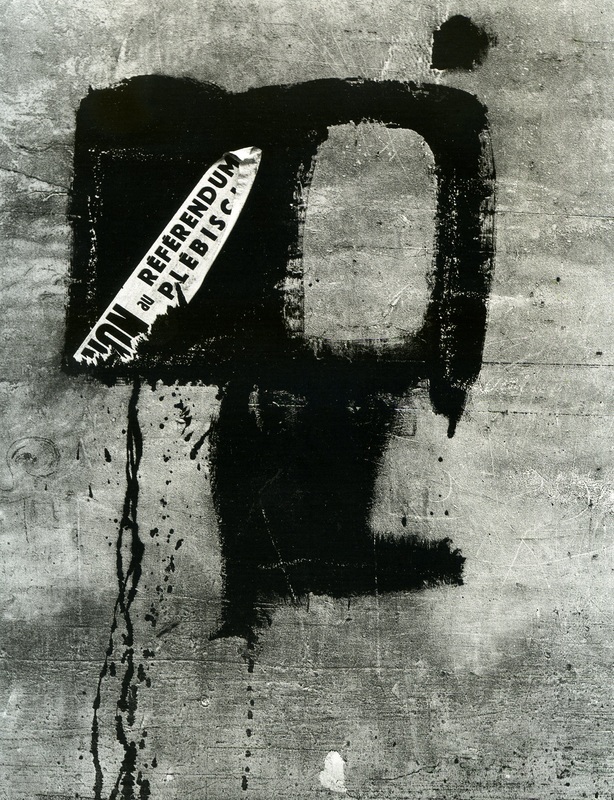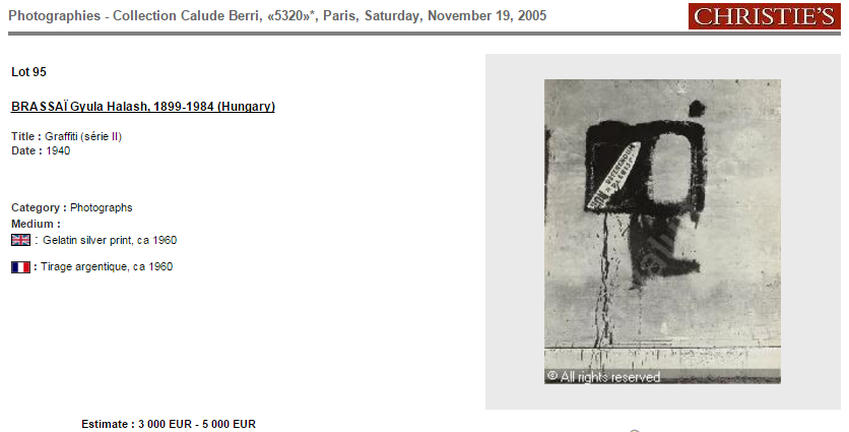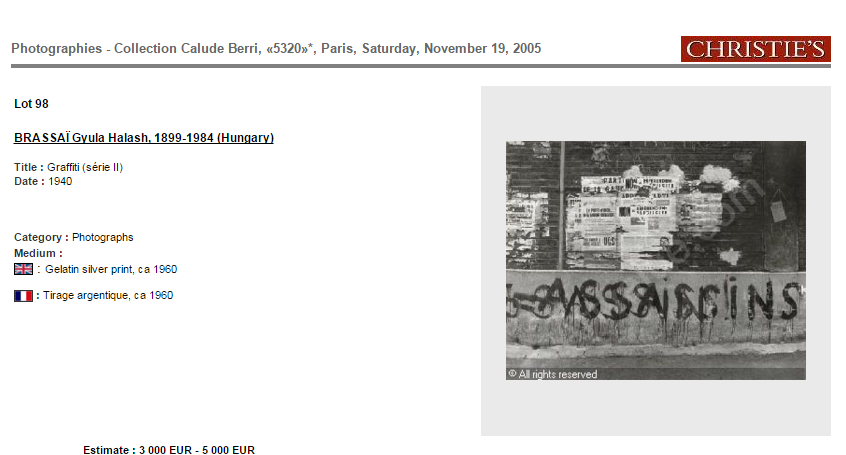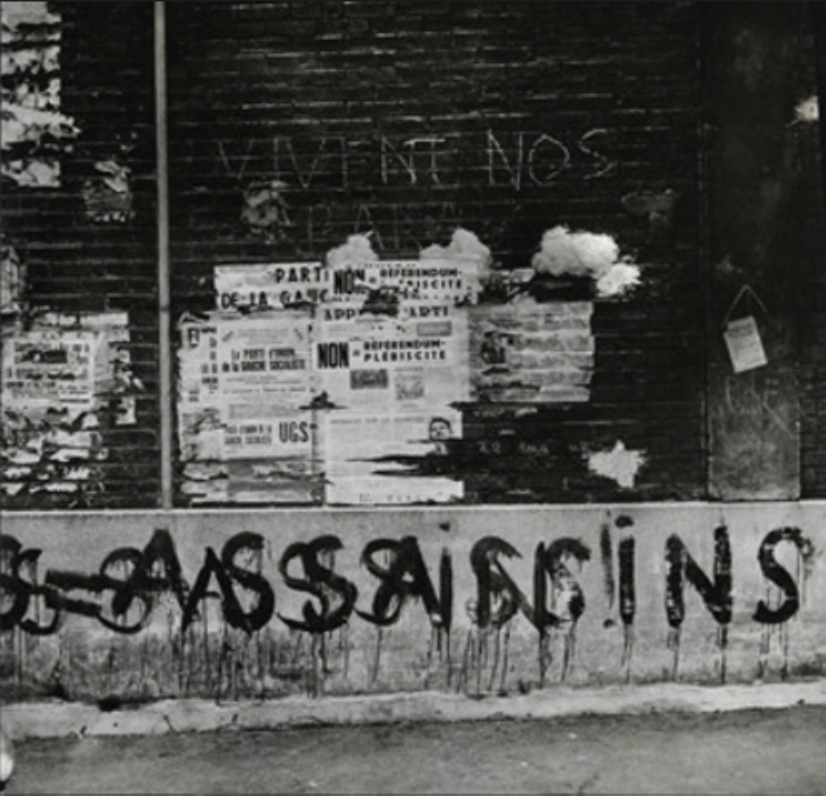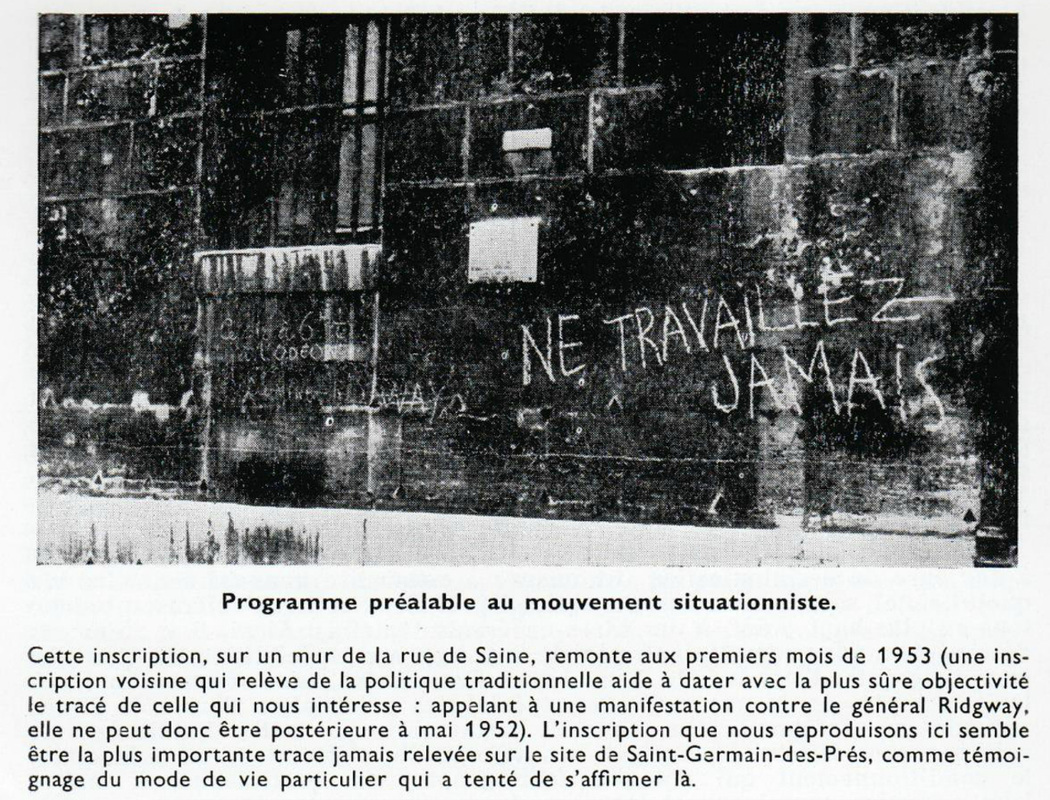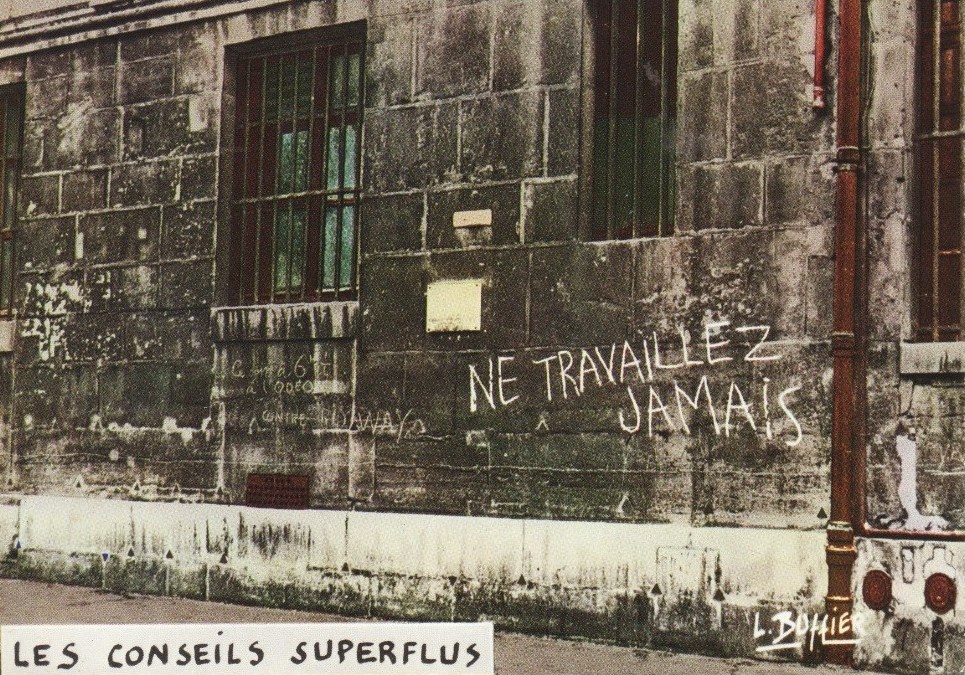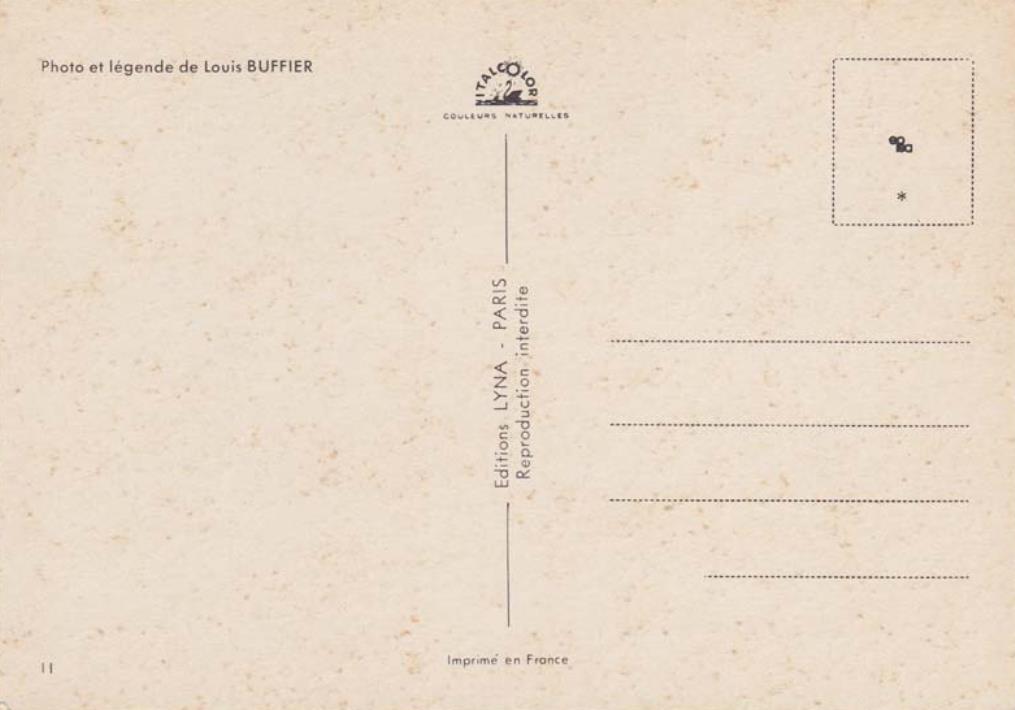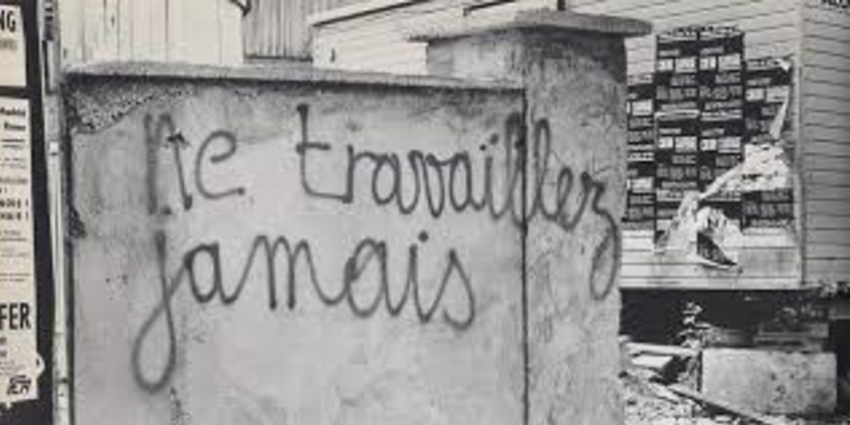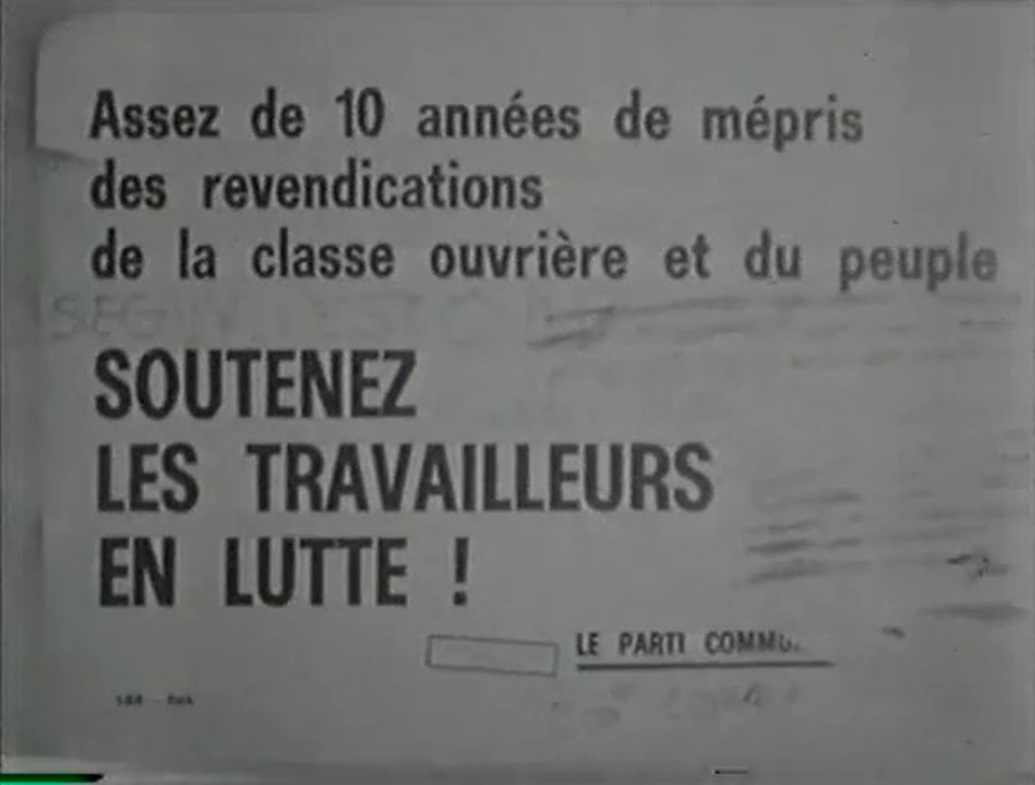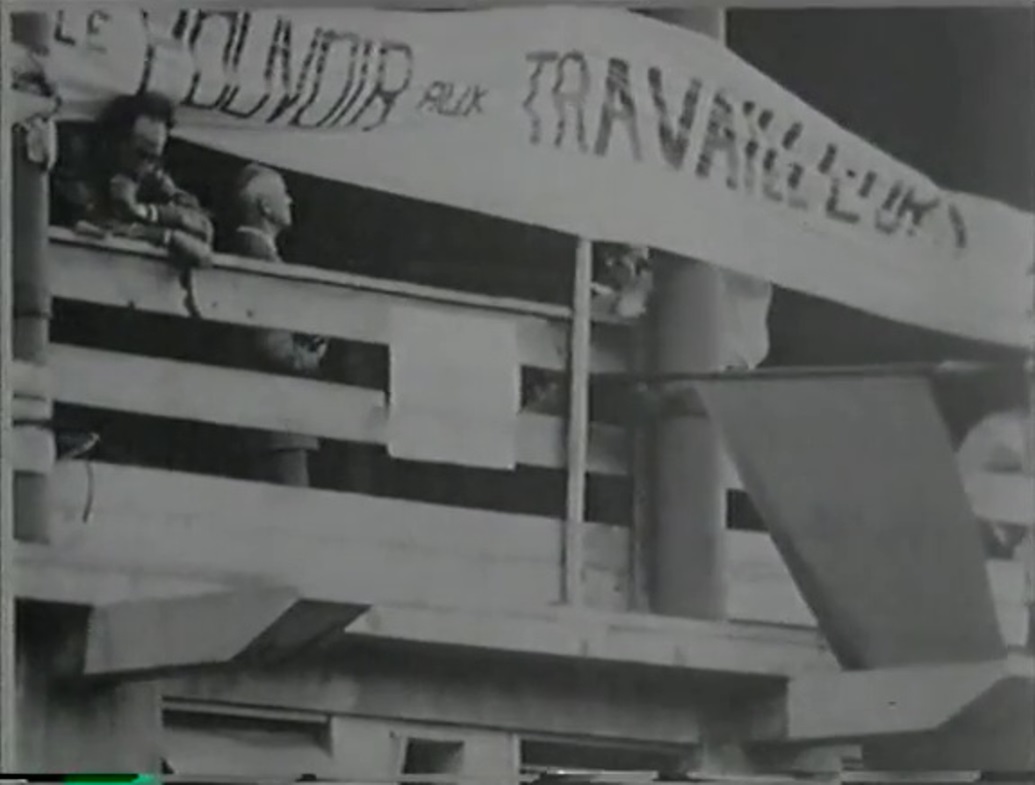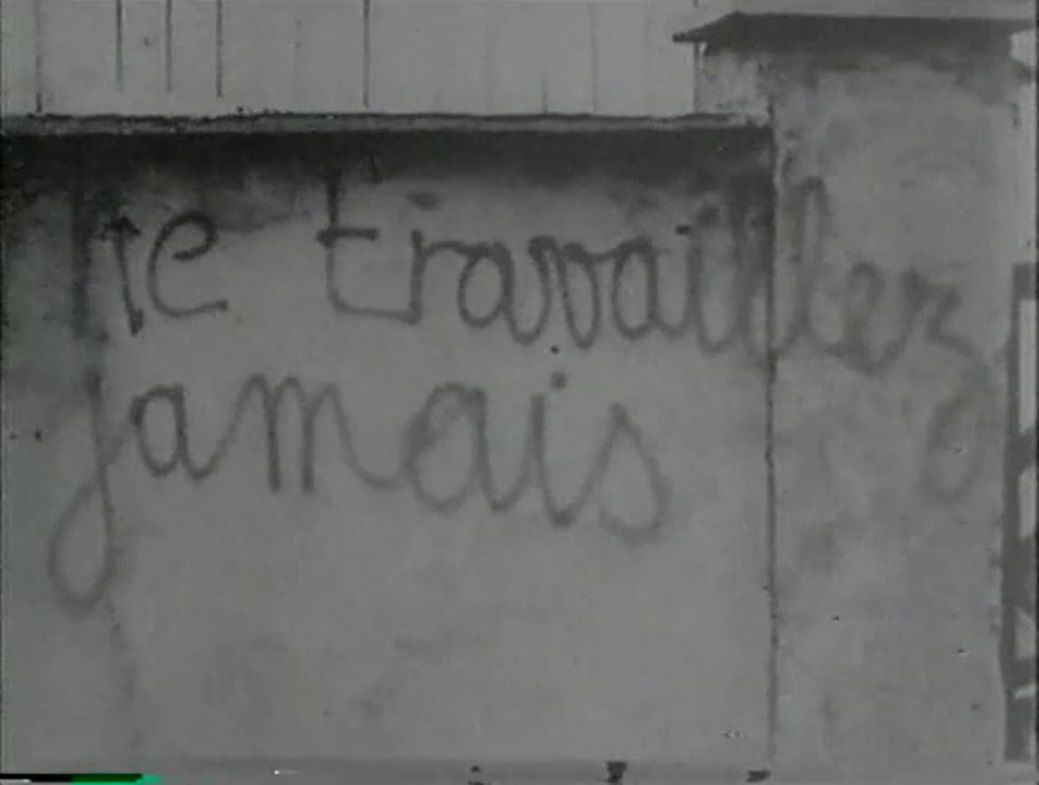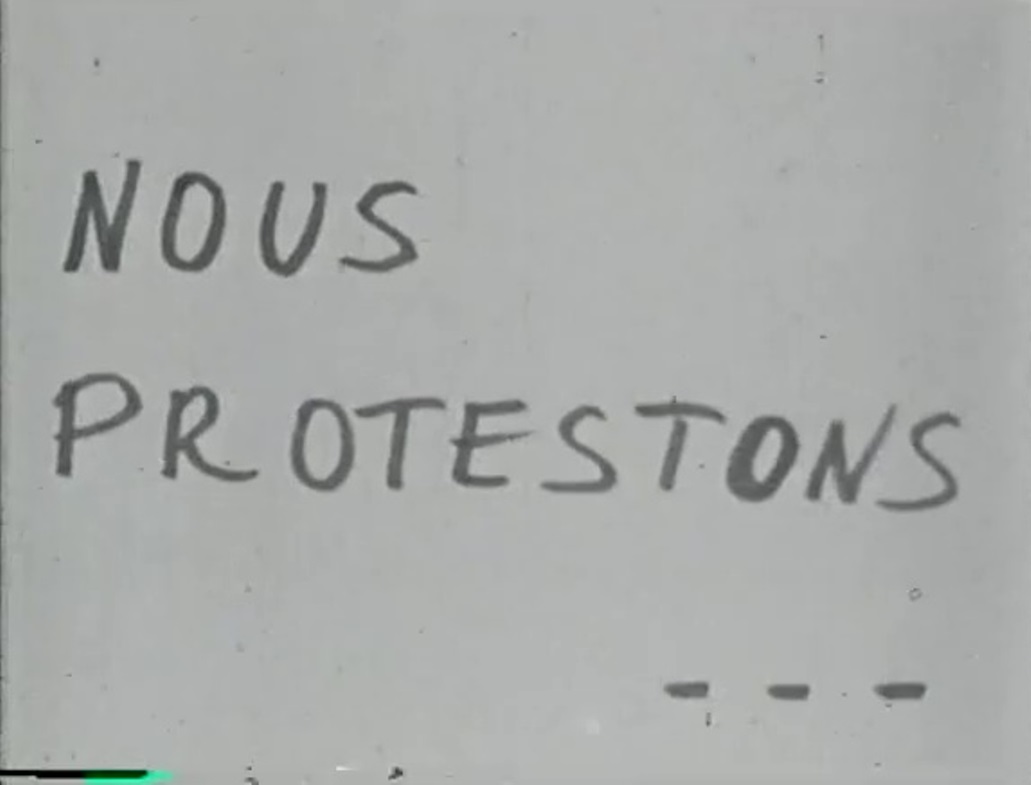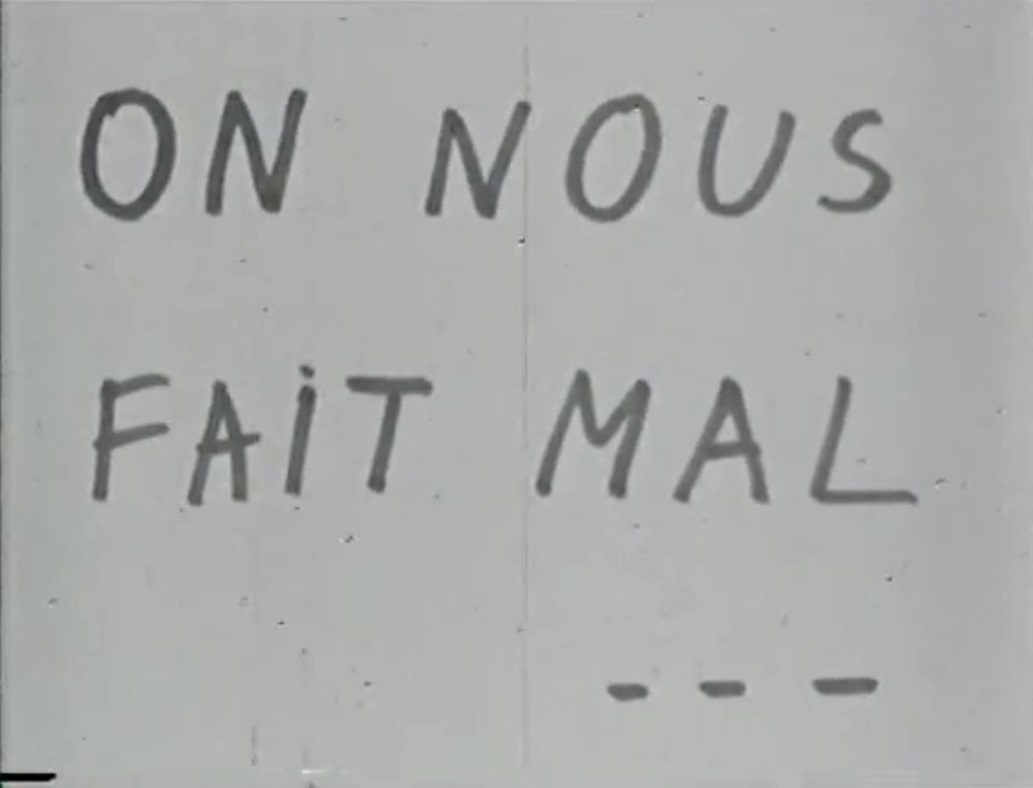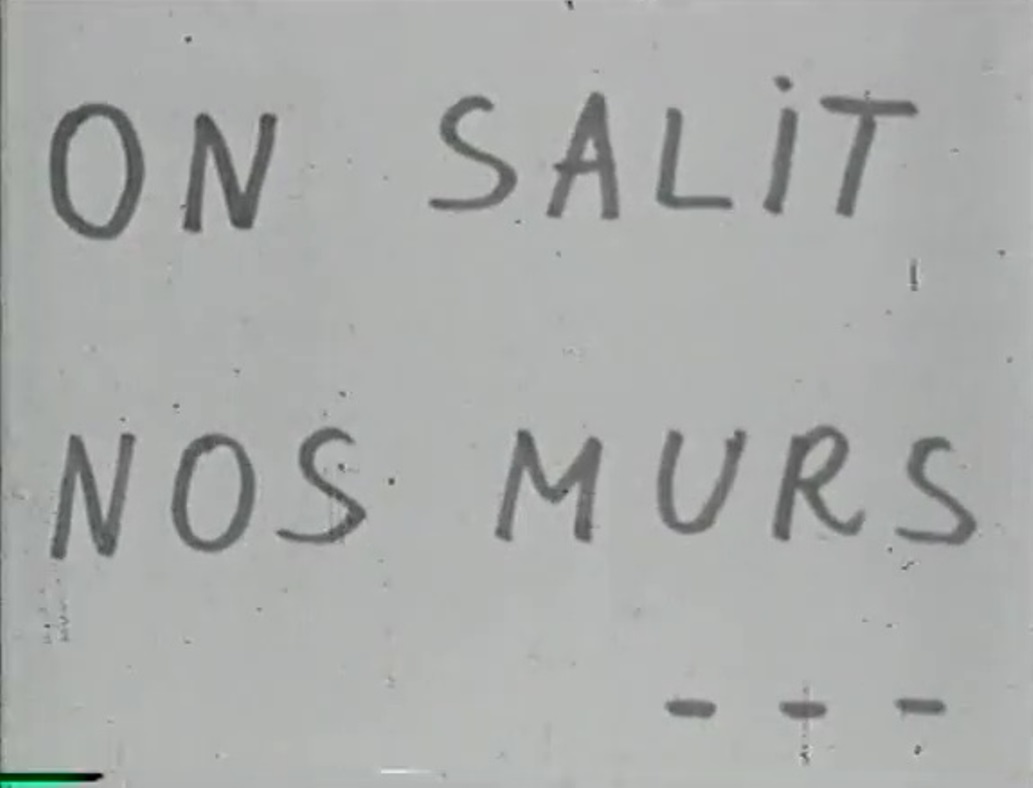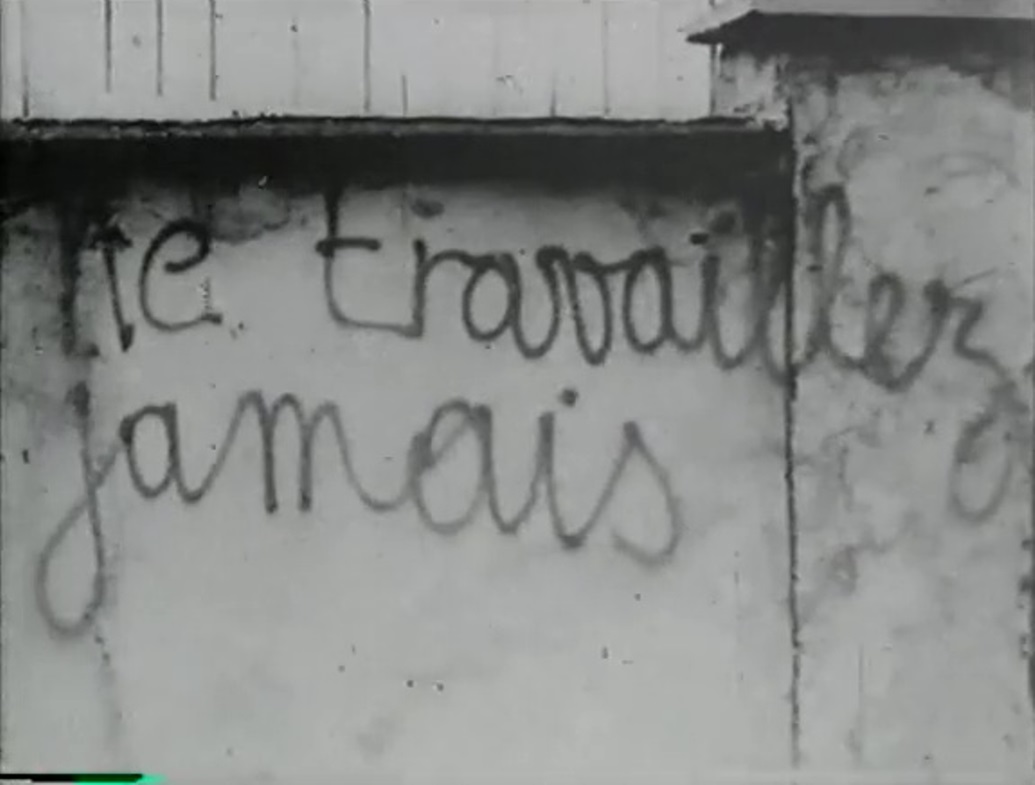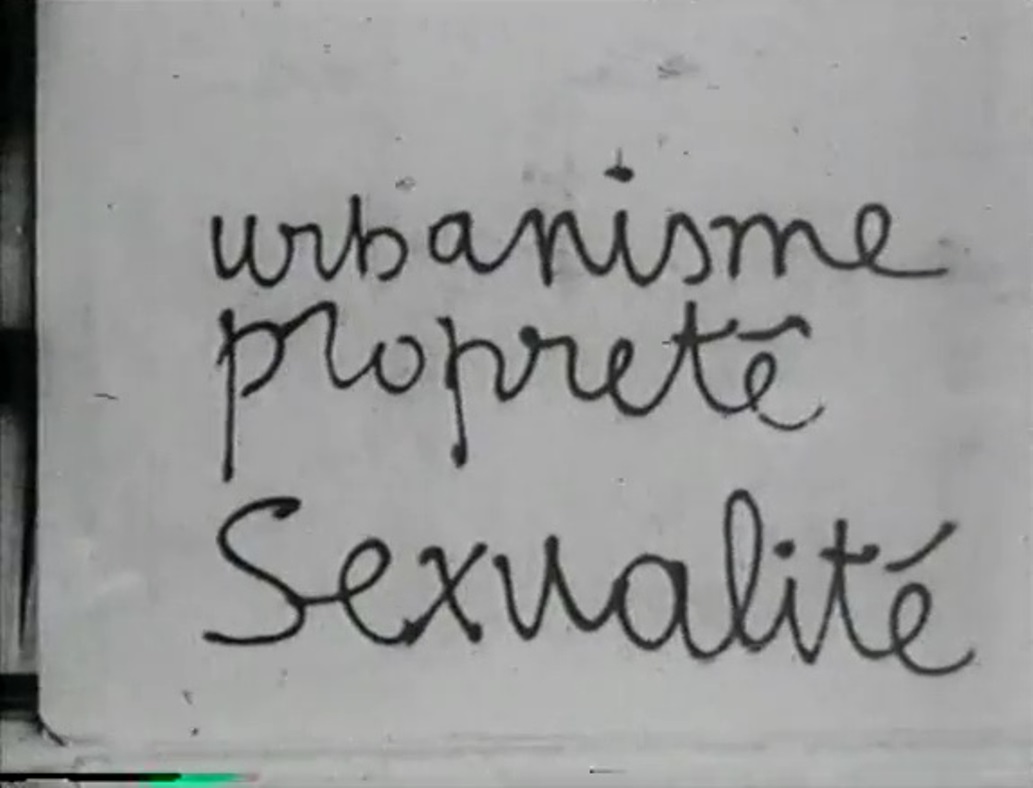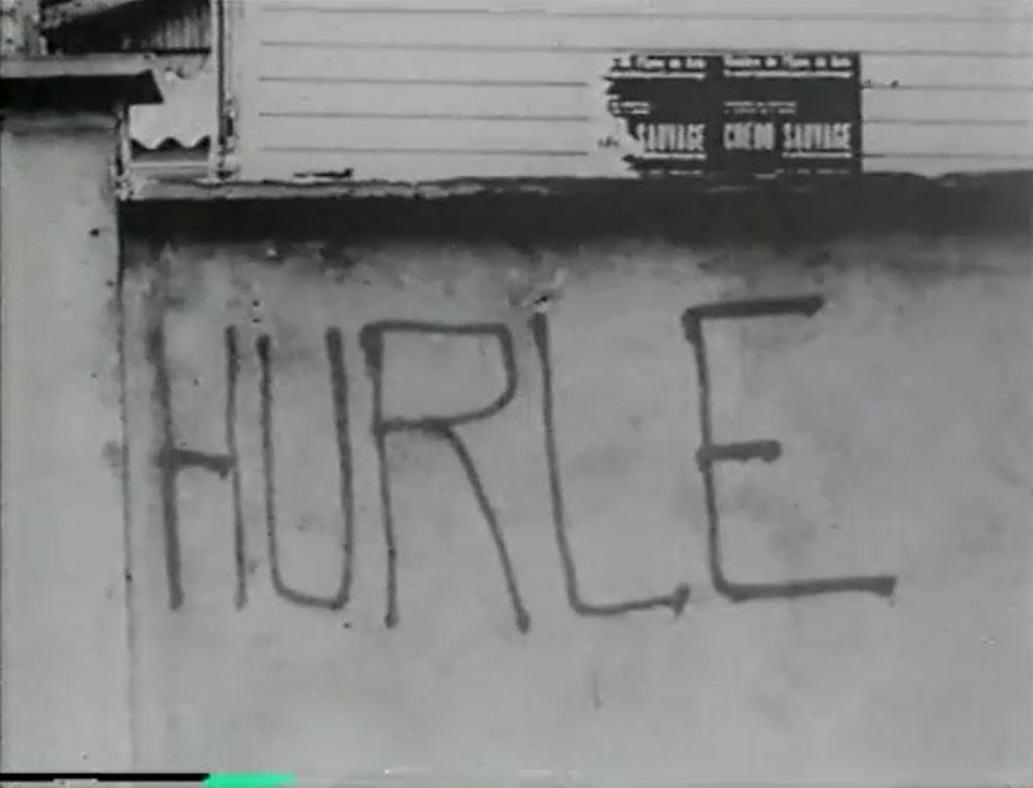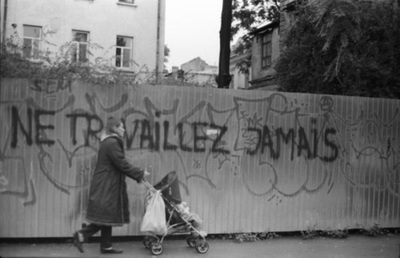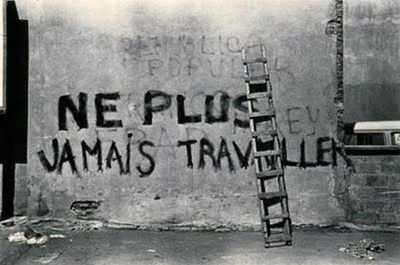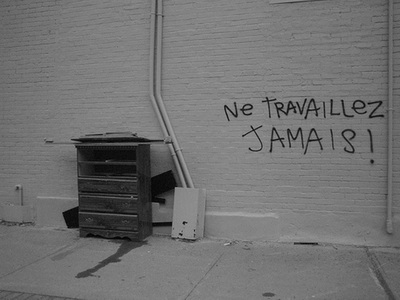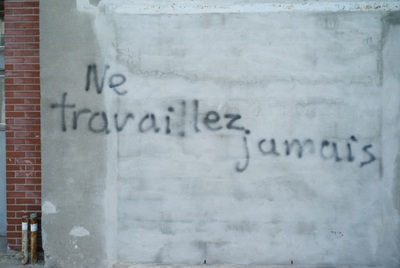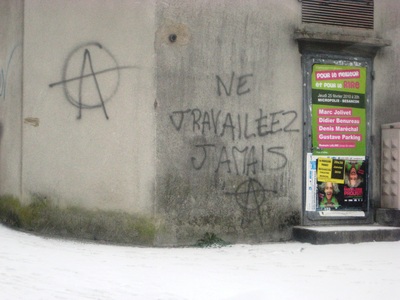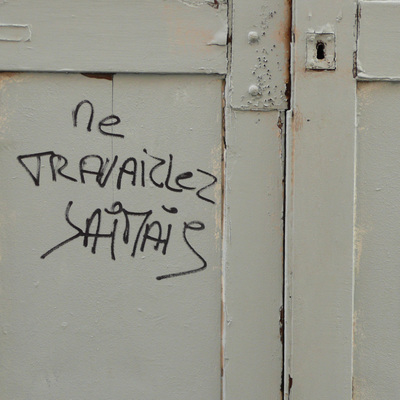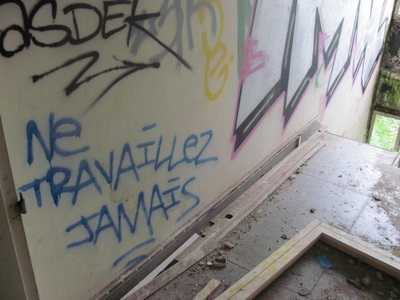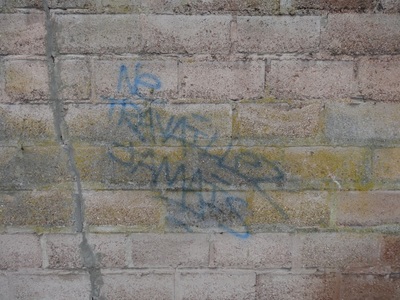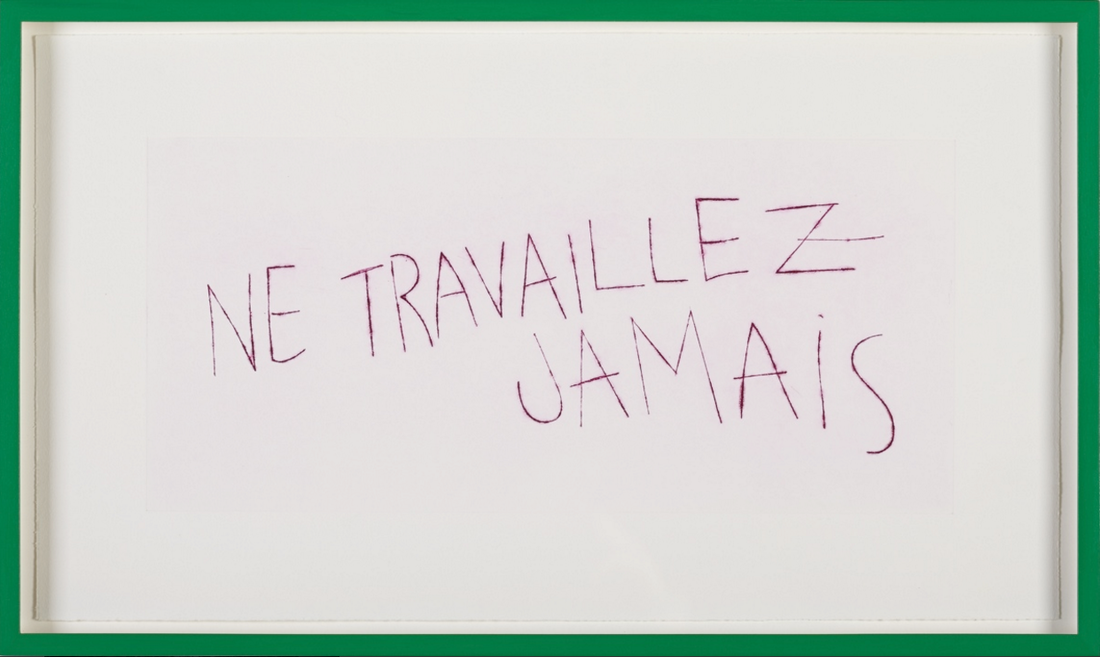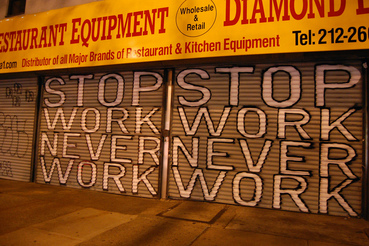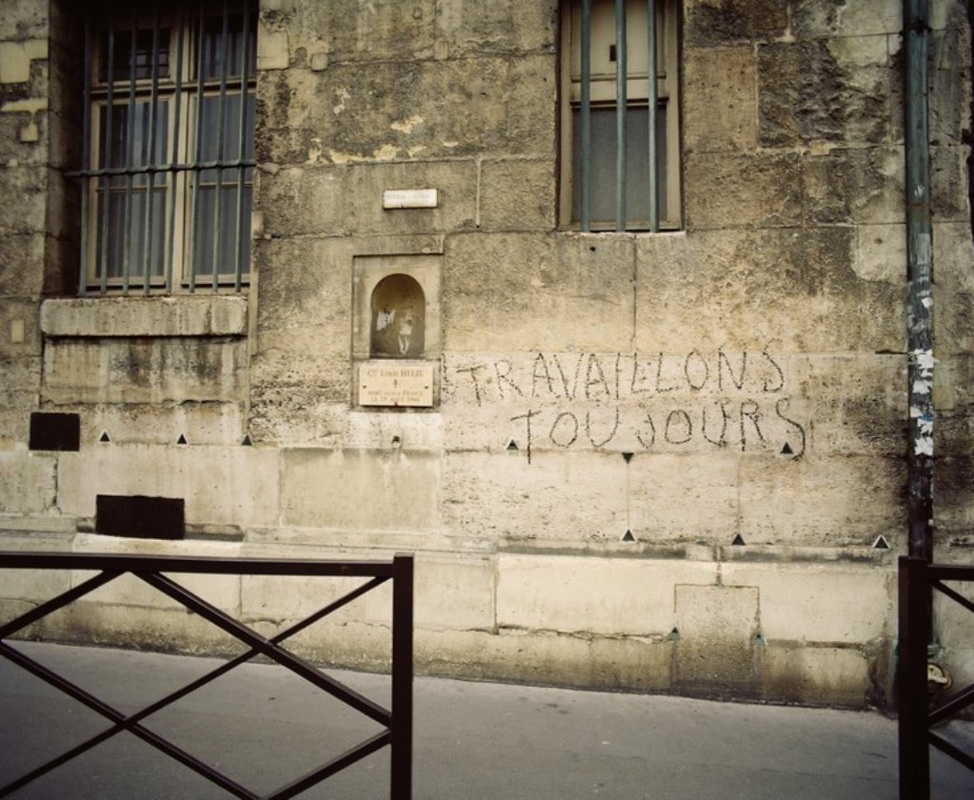the persistence of graffiti: Paris c. 1952
Chabrol's Les Cousins was shot in July and August 1958. Behind Gérard Blain as he crosses the rue Saint Jacques, at the junction with the rue Cujas, can be seen some faded graffiti: 'GO HOME R...' and 'LE TUE...'. It is easy to complete the latter as 'Le tueur', 'the killer', but not easy to know exactly who the 'R' is who should go home. By 1965 such an injunction would be directed at the U.S. army, as in Godard's Masculin-Féminin, when Jean-Pierre Léaud and Michel Debord shout 'U.S. Go Home' at the occupants of the vehicle they have just graffiti-ed:
The graffiti in Les Cousins cannot be Vietnam-related - at the time the U.S. was involved only in an advisory capacity. A clue to context lies in the fact that the graffiti is faded, indicating that it dates from an earlier time:
And an explanation of the graffiti is supplied by a photograph of the same street corner, taken six years earlier:
The graffiti relates to the appointment in 1952 of General Ridgway as supreme commander of U.S. forces in Europe, replacing Eisenhower. On May 28 a demonstration was held in Paris, repeating accusations that when in charge in Korea Ridgway had sanctioned the use of germ warfare against the North, hence 'le tueur macrobien'. Another graffiti from this moment, across the city on the boulevard de Rochechouart, calls Ridgway 'la Peste', the plague:
Ridgway had just arrived in Paris; this photograph shows him in 1953, just before he is about to 'go home'. He is in the middle, French President Vincent Auriol is second from the right:
The two photographs of Ridgway-related graffiti I have reproduced are the only ones on the Paris en images site, and I don't know how much more such graffiti went up across Paris in May 1952. The only related instance I have found is this, from a wall on the rue de Seine:
It is an invitation to meet that evening at 6.15 at the Odéon, 'contre Ridgway', though which evening isn't specified. The photograph was apparently taken in 1953; I am surprised that this most ephemeral of messages lasted long enough to be photographed.
The graffiti still visible six years later in Les Cousins was on the University's Law Faculty building. Again it seems surprising that stronger efforts weren't made to remove it, but I have no real way of gauging how normal is that graffiti's persistence. I can see from Google Street View that it is no longer there:
In his collection of Paris graffiti, published 2010, Christian Colas reproduces surviving examples going back to the sixteenth century, but also this, which he says is from May 1952:
'LIBERONS TOUS J. DUCLOS', 'Let us all free J.Duclos'; this relates to the emprisonment of Communist leader Jacques Duclos after the anti-Ridgway demonstrations. Colas found the graffiti on the avenue de la Porte des Poissonniers. He doesn't explain how it survived more than 50 years, but like most of the earlier examples he shows it must have been in some way hidden.
The preservation of the Duclos graffiti is not assured, except of course as photographic reproduction, the standard mode of survival for graffiti. That mode is supplemented by transcription, as in catalogues of May '68-related texts such as this. Transcription only records the content, of course. Recording the form requires that the graffiti be photographed or filmed:
The recording angel of Paris graffiti was Brassaï, and his interest was almost exclusively in form. When he photographed texts it was to record the transformations effected by attempts to efface them. 'Each letter is converted into another from some imaginary alphabet, and a curious writing system is born, hermetic, enigmatic, of strange beauty':
Or else to record the emotion in the graffitist's gesture. 'A word inscribed by hand in huge letters has an impact that no poster can possibly have. Imbued with the emotion and anger of the gesture that made it, it holds forth, barring the way forward':
On the word 'ASSASSIN!' has been superimposed the word 'ASSASSINS'. The above is from his 1960 collection of graffiti. A differently cropped print reveals a little more of the graffiti, showing that the superimposition had read '...S = ASSASSINS':
Brassaï's framing leaves out the information that would have given the graffiti a historical context. We don't know who these assassins were, though a first thought would be the OAS ('Organisation Armée Secrète'), terrorists opposed to the independence of Algeria:
But the OAS wasn't formed until after Brassaï's book was published, so his wall must be accusing other assassins. We don't know if the graffitist was anti-fascist or fascist, nor indeed if there was a difference in view between the graffitist who wrote 'ASSASSIN!' and the one who wrote 'ASSASSINS'.
That larger print of the photograph reveals more of the posters above the graffiti and gives clues to the date of the photograph: the UGS ('Parti d'Union de la Gauche Socialiste') was formed in December 1957 and the 'référendum-plébiscite' to which the PCF says 'NON' was to take place in September 1958, so the photograph must be from some time in 1958. The cropped version in Brassaï's book removes the reference to the referendum, but opposite it on the next page he had placed a photograph where the reference is explicit:
That larger print of the photograph reveals more of the posters above the graffiti and gives clues to the date of the photograph: the UGS ('Parti d'Union de la Gauche Socialiste') was formed in December 1957 and the 'référendum-plébiscite' to which the PCF says 'NON' was to take place in September 1958, so the photograph must be from some time in 1958. The cropped version in Brassaï's book removes the reference to the referendum, but opposite it on the next page he had placed a photograph where the reference is explicit:
Strangely, when prints of these two photographs were auctioned at Christie's in 2005 (part of a collection belonging to filmmaker Claude Berri), the auctioneers dated them both to 1940:
A different version of the 'Assassins' photograph included in a 2008 exhibition in Madrid revealed even more of what else was on the wall photographed by Brassaï:
Above the left-wing posters is chalked 'VIVENT NOS PARAS', 'Long live our parachutists'. This is almost certainly a right-wing, pro-Algérie française graffiti. I'd make the a faint suggestion - as faint as the graffiti itself - that the missing word that ends in S in the bottom third of the photograph might be 'PARAS'. I have not seen any similar graffiti or slogans from that time, though two years later troops returning from Algeria would be greeted by protests and cries of 'PARAS ASSASSINS'.
The larger print shown in Madrid, by including the reference to paras, is a more politically explicit image than the one Brassaï himself published in 1960, while the war in Algeria was still ongoing. I suspect that the Madrid print was produced from the negative without a thought for why, 48 years before, Brassaï had cropped it. He died in 1984, so it would have been his widow Gilberte who oversaw the 2008 exhibition.
The larger print shown in Madrid, by including the reference to paras, is a more politically explicit image than the one Brassaï himself published in 1960, while the war in Algeria was still ongoing. I suspect that the Madrid print was produced from the negative without a thought for why, 48 years before, Brassaï had cropped it. He died in 1984, so it would have been his widow Gilberte who oversaw the 2008 exhibition.
To close this post I want to go back to 1952 and the politically explicit graffiti relating to General Ridgway. The third instance I had found was in fact a small detail of a larger, very famous photograph:
This is from the 8th issue of the Internationale Situationniste, published in January 1963. The accompanying comment uses the 'politically traditional' graffiti relating to Ridgway (beneath the window) as evidence for dating the revolutionary graffiti 'NE TRAVAILLEZ JAMAIS', 'NEVER WORK'. The graffiti was written by Guy Debord, and the story of his claim to authorship is well-known - see here for his wonderfully dry letter to a publishing industry association that had sought an indemnity from the Internationale Situationniste for having used the photograph without permission.
The detail of the story that interests me is that this famous graffiti only survived by chance. Written in chalk, it must soon have been washed off; Debord didn't photograph it and seems to have forgotten it until the appearance of this humorous postcard, some time before 1963:
The detail of the story that interests me is that this famous graffiti only survived by chance. Written in chalk, it must soon have been washed off; Debord didn't photograph it and seems to have forgotten it until the appearance of this humorous postcard, some time before 1963:
Buffier's chance encounter with Debord's inscription ensured its survival, and the re-appropriation of Buffier's photograph by the Situationists ensured its fame. It was remembered and retranscribed by a graffitist in May 1968:
And thence appeared in at least two of the Ciné-tracts. In Ciné-tract 21 it serves as counterpoint to a discourse on workers' demands:
In Ciné-tract 18 it illustrates an irony-laden bourgeois discourse of complaint about the protesters, coming emblematically first in a series of photographs showing how graffiti 'dirties our walls':
The posterity of Debord's phrase is assured by more recent graffitists, such as those assembled at the fragmentsdetags blog:
And also by artists:
I particularly like a 2009 piece by Marianne Heier called 'Jamais-Toujours' because of its site-specificity:
Her phrase correcting Debord's phrase was written in the same place on the same wall as his, and stayed there five days. Her photograph brings out the contrast with the one permanent inscription on that wall, a plaque in memory of Louis Hélie, a Resistance fighter shot here in August 1944. I am disappointed, however, that she didn't take the opportunity to reproduce or rephrase the invitation to protest at the presence of General Ridgway in Paris. It would have further contrasted the permanent and the ephemeral, and rounded off this post nicely.
References
Brassaï, Graffiti (Paris: Flammarion, 2002)
Christian Colas, Paris graffiti: les marques secrètes de l'histoire (Paris: Parigramme, 2010)
Brassaï, Graffiti (Paris: Flammarion, 2002)
Christian Colas, Paris graffiti: les marques secrètes de l'histoire (Paris: Parigramme, 2010)
